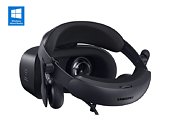Monday, October 22nd 2018

Samsung Announces HMD Odyssey+ with a Display Technology That Says Goodbye to Screen Door Effect
Mixed reality headsets seem to present a new opportunity for the Virtual Reality segment, and Samsung has taken advantage of this trend by announcing the new Samsung HMD Odyssey+, a product that stands out for a novelty in its OLED displays that eliminates the screen door effect. This is a visual artifact of displays where the fine lines separating pixels become visible on the screen. This effect hurts the visual experience, but it can also cause dizziness or nausea.
Samsung say they have solved the problem with an innovation called "Anti-Screen Door Effect (Anti-SDE) Display". This technology helps to increased the perceived resolution of the displays, and according to Samsung the user will have a perceived screen density of 1,233 PPI. The actual density is 616 PPI on a conventional AMOLED, but with the new Anti-SDE AMOLED technology that resolution promises to double virtually before our eyes.In addition, the new Samsung HMD Odyssey+ offers support for 360° spatial sound that simulates 3D audio on the built-in headphones. The weight is 590 g and the design of the glasses is a slight variation of last year's model that offers a little more space in the protection of the eyes (146 vs 138 mm) and the nose (40 vs 32 mm). This headset includes two pre-paired controllers, 110° Field of View and 6 Degrees of Freedom (6DOF) tracking.
The new Samsung HMD Odyssey+ is available today in the United States at the same price as last year's model: $499.99. It's a pity, but at the moment this headset does not make use of that new VirtualLink connection that NVIDIA has tried to promote in its new GeForce RTX 2000 graphics family. We'll have to wait for real, independent reviews to confirm if we can say goodbye to that annoying Screen Door Effect, though.
Source:
Samsung
Samsung say they have solved the problem with an innovation called "Anti-Screen Door Effect (Anti-SDE) Display". This technology helps to increased the perceived resolution of the displays, and according to Samsung the user will have a perceived screen density of 1,233 PPI. The actual density is 616 PPI on a conventional AMOLED, but with the new Anti-SDE AMOLED technology that resolution promises to double virtually before our eyes.In addition, the new Samsung HMD Odyssey+ offers support for 360° spatial sound that simulates 3D audio on the built-in headphones. The weight is 590 g and the design of the glasses is a slight variation of last year's model that offers a little more space in the protection of the eyes (146 vs 138 mm) and the nose (40 vs 32 mm). This headset includes two pre-paired controllers, 110° Field of View and 6 Degrees of Freedom (6DOF) tracking.
The new Samsung HMD Odyssey+ is available today in the United States at the same price as last year's model: $499.99. It's a pity, but at the moment this headset does not make use of that new VirtualLink connection that NVIDIA has tried to promote in its new GeForce RTX 2000 graphics family. We'll have to wait for real, independent reviews to confirm if we can say goodbye to that annoying Screen Door Effect, though.




8 Comments on Samsung Announces HMD Odyssey+ with a Display Technology That Says Goodbye to Screen Door Effect
Some magic sauce that decreases the screen door effect SDE is all good and well but I personally need to know how they did it as well as any possible side effects PSE of the tech before I can care too much about it.
I have an Oculus Rift too. Its nice to see incremental improvements from competing manufactures of HMDs. This to me is a fairly good indicator that the HMD market is healthy and growing. Personally I am more interested in true next gen HMDs over this though.
I'd also like to see more unification of standards for HMDs and I would like to see less or no exclusive titles. Let the walled gardens fall.
If Samsung is on to something here then great but they need to come with the details either way. Otherwise I have "what you talking about willis" meme ready to go,....
The Vive Pro is the gold standard IMO. While the PiMax 5K, 8K and 8K X have some great specs all indications seem to be that the are considerably more fiddly. Also their marketing seems deceptive in terms of the "8K" moniker and if the so named 8K version has lower overall video quality then the 5K they shouldn't have even launching it. They should have just gone with the 5K and 8K X models IMO.
Basically I am saying I trust Vive and Oculus more then PiMax and IMO that is really saying something since Facebook owns Oculus.
Oculus Quest is intriguing.
I have to believe that there will be some price adjustments to the Oculus Rift if for no other reason then having two Oculus HMD's at the same ~$399 retail price will invite confusion (for some). The Oculus Go, Quest and Rift creat a rounded out line up but I question the logic somewhat. Having two mobile HMD's seems unnecessary.
IMO, the logical approach would be to have one mobile HMD, one PC HMD and one hybrid that can function as either mobile or PC HMD. Perhaps a standard and Pro PC HMD like the Vive and Vive Pro would work for Oculus too in addition to mobile and hybrid.
A hybrid HMD would have a mobile SoC and inside out tracking but could also be connected to a PC to use the PC graphics (wired or wireless) and possibly improve on tracking with PC connected sensors for outside in tracking. Mobile and PC gaming all in one.